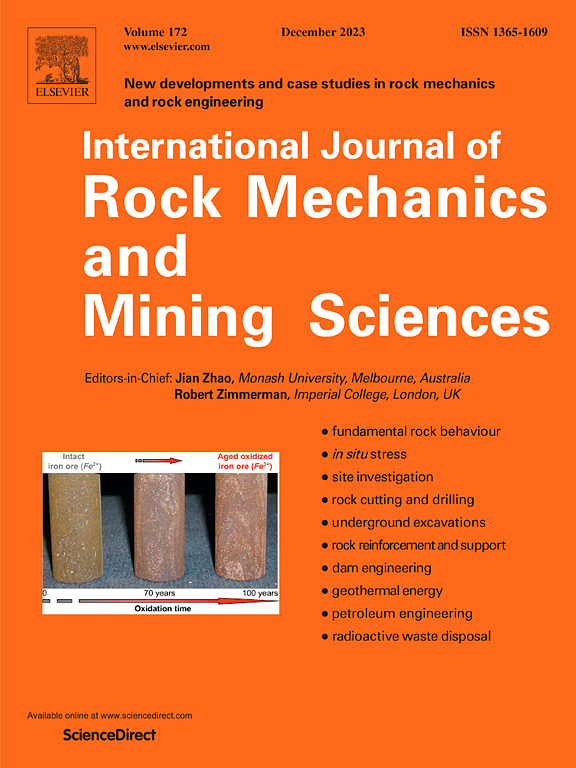在评估花岗岩拉伸行为时,参照变形率和试样几何形状对环形试验进行评估
IF 7
1区 工程技术
Q1 ENGINEERING, GEOLOGICAL
International Journal of Rock Mechanics and Mining Sciences
Pub Date : 2024-11-26
DOI:10.1016/j.ijrmms.2024.105973
引用次数: 0
摘要
用于间接测量拉伸强度的环形试验采用圆盘试样,圆盘中心有一个孔。这种试样可限制试样与平板接触处的应力,并将拉伸应力传递到环形试样的上下孔边界。研究人员发现,环形试样的拉伸强度会随着孔半径与盘半径之比 (ρ) 的增大而减小。然而,对于环形试样在不同的准静态应变率或变形率下加载时的抗拉强度如何变化,还没有相关研究。环形试验的应变分析似乎也没有得到重视。在这项研究中,以 0.5 毫米/分钟、1.5 毫米/分钟和 5.5 毫米/分钟的准静态加载速度分别对应 1.75 × 10-4 s-1、5.26 × 10-4 和 1.93 × 10-3 s-1 的应变速率,对不同 ρ(0.13、0.17、0.21 和 0.25)的马兰吉坎德花岗岩(印度)环形试样进行了测试。研究了变形率和试样几何形状 (ρ) 对间接拉伸强度和变形行为的综合影响。结果发现环拉伸强度(RTS)高于巴西拉伸强度(BTS)。RTS 既取决于环形试样的几何形状,也取决于变形率。本研究根据拉伸应力和垂直-水平应变数据估算了拉伸切线变形模量(Dv)和水平应变与垂直应变之比,即环形应变比(RSR)。此外,还使用 Abaqus 进行了数值有限元分析,以观察环形盘和巴西盘的应力分布,结果发现两者基本一致。本文章由计算机程序翻译,如有差异,请以英文原文为准。
Evaluation of ring test with reference to deformation rate and specimen geometry in assessing the tensile behaviors of granite
Ring test for indirect tensile strength measurements utilizes disc specimens with a hole at the center of the disc. Such specimens are found to limit the stresses at the specimen-platen contact and transfer the tensile stress to the upper- and lower-hole boundaries in ring specimens. Researchers observed that the tensile strength of a ring specimen tends to decrease as the ratio of the hole-radius to the disc-radius (ρ) increases. However, there has been no research on how the tensile strength derived from ring specimens varies when loaded under different quasi-static strain rates or deformation rates. The strain analysis in case of ring tests also does not seem to have gained attention. In this study, ring specimens of Malanjkhand granite (India) with varying ρ (0.13, 0.17, 0.21 and 0.25) were quasi-statically loaded at 0.5 mm/min, 1.5 mm/min and 5.5 mm/min corresponding to strain rates of 1.75 × 10−4 s−1, 5.26 × 10−4 and 1.93 × 10−3 s−1, respectively. The combined effect of the deformation rate and specimen geometry (ρ) on the indirect tensile strength and deformation behavior was investigated. The Ring Tensile Strength (RTS) is found to be higher than the Brazilian Tensile Strength (BTS). RTS shows dependency on both the geometry of the ring specimen as well as the deformation rate. The tensile Tangent Deformation Modulus (Dv) and the ratio of the horizontal strain to vertical strain, coined as Ring Strain Ratio (RSR), were estimated in this study from the tensile stress and vertical-horizontal strain data. A numerical finite element analysis was also performed in Abaqus to observe the stress distribution in both ring and Brazilian discs, where the results were found to be broadly conformable.
求助全文
通过发布文献求助,成功后即可免费获取论文全文。
去求助
来源期刊
CiteScore
14.00
自引率
5.60%
发文量
196
审稿时长
18 weeks
期刊介绍:
The International Journal of Rock Mechanics and Mining Sciences focuses on original research, new developments, site measurements, and case studies within the fields of rock mechanics and rock engineering. Serving as an international platform, it showcases high-quality papers addressing rock mechanics and the application of its principles and techniques in mining and civil engineering projects situated on or within rock masses. These projects encompass a wide range, including slopes, open-pit mines, quarries, shafts, tunnels, caverns, underground mines, metro systems, dams, hydro-electric stations, geothermal energy, petroleum engineering, and radioactive waste disposal. The journal welcomes submissions on various topics, with particular interest in theoretical advancements, analytical and numerical methods, rock testing, site investigation, and case studies.

 求助内容:
求助内容: 应助结果提醒方式:
应助结果提醒方式:


